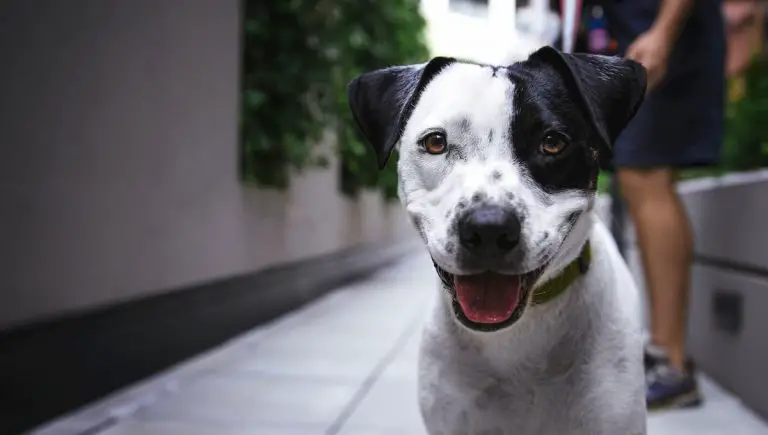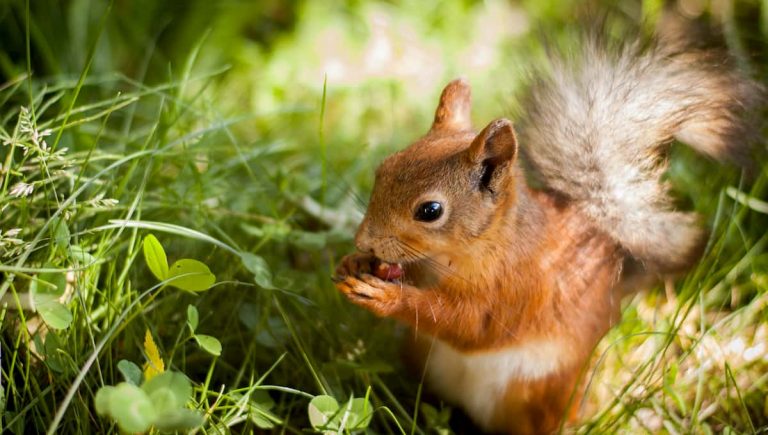How To Train Your Dog to Sleep Outside

As man’s best friend, canines bring joy and comfort into our lives. As much as we love our dogs, sharing our beds and inside spaces with them is not always feasible and could result in interrupted sleep for you and your family. Establishing boundaries is critical, which is why it’s important to learn how to train your dog to sleep outside.
The topic of dogs sleeping outside is often received with mixed reviews where animal lovers think it’s cruel and inhumane. However, there’s a case for our four-legged family members sleeping outside if the shift from inside to outside living is done gradually.
At the same time, the move could prove beneficial not just for you but also for your pet by helping with behavioral issues, such as separation anxiety. Teaching your dog independence while you are at work or away will result in a happier animal that can be on its own for longer periods.
So can dogs sleep outside? The answer is yes, but the relocation needs to be done slowly and correctly. The transition isn’t an easy fix but requires endless patience and time. Read on to find tips and tricks that will make the adjustment easier on your pooch, must-haves for outdoor life, and scenarios where dogs don’t belong outdoors.
Should Dogs Sleep Outside?
It’s only recently where dogs, for the most part, have stopped sleeping outdoors. One reason is that humans are moving into smaller homes, such as townhouses or apartments that don’t have a yard.
However, the truth of the matter is that dogs love to explore and don’t want to be cooped up indoors all of the time, which is when a backyard comes in handy.
If your dog paces up-and-down at night and can’t seem to settle down, he or she may be more geared toward the outdoors and might be a happier hound for it.
Remember that dogs have an instinctive nature and may be more inclined to the outside world where they can roam free and communicate with other dogs in the area.
Of course, not all breeds of dogs can cope with living outside, and if your dog is old and sickly, the environment won’t be appropriate either. However, if your dog is young, healthy, and acclimatized to the weather, then there’s nothing wrong with keeping your dog outdoors.
Making an Inside Dog an Outside Dog

As the saying goes, “you can’t teach an old dog new tricks,” which is something to bear in mind if your dog is accustomed to several years of inside living. Factor in its age when preparing your canine for the outside world because it will be harder to train an older dog than a puppy.
For some people, dogs sleeping outside is not a matter of if, but when. Have you just brought home a young dog and want to know when can a puppy sleep outside? The answer is not straightaway and here’s why:
- Your puppy can’t regulate its body temperature like a grown adult dog, which means that it’s vulnerable to the elements. Your puppy needs to grow to the right size and weight so that he or she can adjust to different weather, such as extreme heat or freezing conditions.
- Like human babies, your puppy is more susceptible to a myriad of diseases and parasites than its fully-grown counterparts. So puppies can only sleep outside once they’re up-to-date on all of the essential vaccinations.
So can a nine-week-old puppy sleep outside? While the approximate age where puppies can sleep outside varies between pet owners, between four to six months is usually recommended.
How to Get Puppies and Dogs to Sleep Outside
The question of when can a dog sleep outside has been answered, but now to answer the “how.”
There’s no one true method on how to transition your dog to be an outside dog; you may get several different answers from dog trainers, as well as owners who have successfully trained their pets. At the same time, what works for some breeds may have no impact on yours.
Start your puppy or dog training knowing that change doesn’t occur overnight, and that patience is vital. You must understand that this is a confusing and unsettling time for your dog.
Successful Tried-and-Tested Methods
When it comes to training puppies, the task of encouraging them to sleep outside isn’t nearly as challenging as you might think. Younger pooches are more receptive to changing their behavior and learning new rules. The hardest part is the first step, self-restraint, which may be difficult when your beloved pooch is giving you his or her best “puppy eyes.”
The time-frame for the training varies according to the breed and temperament of your dog, from a few days, weeks, or if your pooch is particularly clingy, a couple of months.
The “Setting-The-Scene” Method
Getting Ready
Before you get started, you’ll need to find an appropriate spot to set up your dog’s bed. You should also buy tasty treats and bring along their favorite toys.
This exercise aims to get your dog to a point where he or she begins to recognize this space as his or her territory, and where he or she feels comfortable sleeping.
Positive Associations Only
For this to happen, the area must be regarded positively, and not where you send your pooch when they’re in trouble. They may go, but unwillingly, unhappily, and won’t view the sleeping area as a particularly safe space.
Treats
Tempt your dog by leaving treats near their beds in the evenings before bedtime. In time, your pooch will begin to associate their sleeping quarters as a place where you give them snacks.
Comfort
A dog’s comfort is the most critical factor, so it’s essential that the living arrangement outdoors emanate the degree of comfort they received while living inside – include a cozy dog bed, blankets, and pillows.
Water
Provide your dog with more water than usual. Otherwise, your dog may scratch and whine in the middle of the night because he or she is thirsty.
Techniques That Slowly Ease Your Dog Into The Outdoors
It’s been mentioned earlier that there isn’t a “one-size-fits-all” to training, and your dog might require a more gradual approach to the one listed above.
The Most Effective Approach Is To Take Your Time By:
Allowing your dog to play in the area where you intend for them to sleep for a couple of minutes a day. Then leave them unattended but stay close by. Repeat this every day and extend the time they are left alone. By doing so, you are teaching your fur child independence.
Take them outdoors for supervised daytime naps – bring out a chair and read a book while your dog rests. Follow your daytime naps with evening naps so that your dog grows more comfortable in the space for longer periods, and at the same time, gets used to being outdoors at night.
For both approaches, allow your dog to sleep inside because a premature permanent move may quickly backfire if your dog isn’t ready.
Handy Advice for Leaving a Dog Outside at Night
You may find that your first attempt at training your dog to sleep outside fails. If this happens, it’s fine to repeat the process because your dog may need more time adjusting to the change and building up confidence in being alone.
Establishing A New Routine
Other ways of easing your dog into its new sleeping quarters are to establish a routine. If you have owned dogs before, you’ll know that they need consistency.
Provide this by saying goodnight and giving them a comforting stroke before bed and greeting them with a good morning and a snuggle when you wake up.
Knowing that you will be there before bed and in the mornings will be a comfort to your pets.
Check on Them
During the initial transition period, check on your dog occasionally throughout the night. Seeing you will reassure them that you’re still around.
Don’t Force The Situation
If your dog isn’t settling well outside, don’t force the situation. On top of being kept awake by howling and scratching, your dog could develop entrenched fears of the outside world, to the point where the chance of getting them to sleep outside becomes minimal.
Permit them to sleep inside, and try again at a later date.
Must-do’s for Puppy-proofing Your Yard

Many individuals are against dogs living outside because of the possible dangers lurking in your garden, such as venomous snakes, toxic plants, the possibility that your dog runs away, not to mention criminals.
These are the precautions you should take before you let your dog sleep outside.
Fence Your Property
Dogs wander. Make sure you’ve installed a high-quality fence that your dog can’t gnaw at and escape to go exploring.
Remove Dangerous Plants Or Replant Them Elsewhere
It’s nice to spruce up your garden with pretty flowers and plants. However, if your dog is prone to chewing, he or she might be in danger of being poisoned if they ingest these plant species.
If you want to hold onto these plants, consider growing them in areas that your pooch doesn’t have access to.
Wildlife
Despite keeping a well-insulated kennel in your backyard, and installing a fence to keep out wildlife, slithering serpents can still creep in.
If you’re worried about potential snake bites, consider moving your canines inside when it’s freezing, because you’ll find that your dog’s kennel is the ideal refuge for a cold snake.
For the most part, you’ll find that vets and animal experts will recommend that you keep your dogs inside during winter, especially puppies, older or sickly animals, and short-haired breeds, which is something we’ll discuss later.
Criminals
This may be a contentious issue for some who regard dogs as an integral part of the family. However, certain breeds make excellent guard dogs, alerting you to the outside dangers and keeping you safe.
Appropriate Shelter to Keep Your Dog Protected From the Elements
A suitable dog kennel is the first thing you should invest in if you plan to have outdoor dogs. When buying your treasured pooch his or her doggy home, you should account for the following features:
- Make sure the kennel is spacious enough for your dog in which to move around. Canines need their space and won’t be happy being confined to cramped areas.
- Ensure there are proper heating and cooling systems in place. The temperature range should sit between 50 and 78.8 degrees, anything lower than 50 is too cold and hotter than the maximum may result in your pet overheating.
Make sure that any cables are out of reach of your animals.
- Shelters must be weather-resistant and made from high-quality materials that don’t rot or decay over time.
Recommended Shelters, Dog Houses, and Heaters to Keep Your Pooch Warm, Comfortable and Happy
Pets Imperial (extra large)
The Pets Imperial is excellent for dogs that sleep outside. The dog house provides your hound with their space while reclaiming your bed.
Why buy it? It’s easy to clean for you, and dry and comfortable for your dog.
Built from supreme-quality, dog-friendly treated timber, the dog house is designed to last for years.
ASL Solutions Dog Palace (Medium to large dogs)
A place of refuge for your pooch that can withstand all types of weather.
Why buy it? It’s elevated, raised flooring ensures warm bedding.
Its self-closing insulated door and insulated padding keep bad weather outside.
Hound Heater Dog House Furnace
Your dog’s happiness and comfort should be a top priority. Purchase a heater to keep chills away.
Why buy it? The model has an in-built heat shield to hold wires and cables and away from too-curious dogs.
The heating system prevents the mechanism from getting too hot and burning your dog.
Is It Okay to Have Dogs That Live Outside in Winter?
Despite their bodies being covered in fur, dogs also feel the cold, and there are risks to keeping your dog outside whatever the season.
If you’re wondering whether dogs and puppies can sleep outside in the cold, the short answer is no. That said, there are specific dogs that are more adept at adjusting to frostier conditions.
Signs That Your Dogs Are Struggling With The Cold And Should Be Moved Inside Immediately Include:
- Don’t leave puppies outside when they’re visibly shivering and shaking.
- They’re curled up in a ball and trying to warm up with their remaining body heat.
- If your dogs are sleeping more than usual and seem lethargic.
- Appear sore and are moving tentatively – winter chills can flare up arthritis, so move your dog to warmer spaces if they have joint issues.
Dogs shouldn’t be left in sub-freezing temperatures for extended periods because frostbite and hypothermia are two very real dangers resulting from prolonged exposure to extremely cold temperatures.
Breeds of Dogs That May Want to Sleep Outside at Night
Siberian Huskies
Due to their big furry coats and undercoats that adequately regulate their body temperature, huskies thrive in wintery conditions.
Huskies love exploring and keeping active, so the outdoors is certainly a playground for them.
Labrador Retrievers
Don’t let their lovable and goofy nature fool you; labs can adapt to a variety of climates, inside and out.
Aussie Cattle Dogs
While originating from a warmer climate, the Aussie Cattle Dog can withstand extreme temperature changes. They’re also extremely outdoorsy and possess independent dispositions – which may make training easier.
German Shepherds
Apart from having a double-layer coat that adapts wells to weather variations, German Shepards are versatile and easy-to-train from a younger age.
Keeping these dogs outdoors, and well-exercised is a must!
Collies
Collies are well versed in the outdoors. They also have dense fur that helps insulate their bodies whether it’s hot or cold.
Make Sure Not to Neglect Your Dogs
While these and other dogs can live outside without fuss, you must give your pooch the care, love, and attention that it needs. Dogs that are neglected or confined to their kennels become highly stressed or bored and may run away.
If your dog frequently escapes your yard to meander the neighborhood, there may well be a reason for that.
Remember that while your dog is outside of the family home, he or she shouldn’t be treated as part of the garden furniture. For the most part, dogs are social animals, found in the wild in packs, do require consistent companionship, and may become lonely or depressed if they don’t receive enough care.
Alternatives to Keeping Your Dogs Outside
Often, people decide to move their dogs outside as a last resort to fix behavior issues. While some of these problems can’t be resolved in any other way, some may require additional training or simple resolutions.
Urinating And Defecating Inside
Urinating or defecating indoors are two primary reasons for forcing your pooch outdoors. However, moving them outside to sleep might not prevent this from happening entirely, especially when your dog has access to your home during the day.
Frequent urination could point to a dog not being adequately toilet-trained, which is an issue that can be resolved with additional training.
The above could point to a health issue, in which case you should seek out professional help.
For an older dog who’s become incontinent or a younger dog not yet toilet trained, these disposable dog wraps may help.
Whining Or Barking
Are you kept up at all hours by your dog? There may be straightforward explanations for this. The barking might result from external disturbances. Move your dog’s bed to a quiet and dark area should cease the issue.
Whining tends to be a cry for help or attention. Make sure your dog is comfortable and warm to help initiate sleep. You should also check collars – one that is too tight may inflict pain or discomfort.
Chewing
Unfortunately, several types of dogs are predisposed to chew where your expensive shoes become collateral damage.
Giving your dog canine-friendly items to gnaw on or chew bones may prevent your valuable items from becoming chew-toys.
Sleeping On The Bed

Despite their perfectly comfortable bed, dogs love sleeping with their humans on theirs. This is because our human beds are comfortable and elevated out of the way of perceived dangers. At the same time, dogs are friendly and like being around their owners, even in sleep.
While we all love a cuddle buddy, sleeping with your dog in your bed isn’t such a great idea because of fleas and dirt, and may lead to aggressive and possessive behavior.
Rather than curbing this behavior by moving their sleeping area outside, try crate training.
Crate training is a viable alternative because the crate emanates a den, which is what dogs seek out in the wild. These crates are cozy, warm, and provide dogs with a sense of security.
At night, if you find that your dog grows restless, crate covers will provide the complete darkness that canines need to remain asleep.
Recap: Teaching Your Dog to Sleep Outdoors
More owners are choosing to let their dogs sleep indoors, but there are good reasons for keeping your dogs outside. This definitive guide will help you to train your dog to sleep outdoors.
- In this article, we’ve discussed the benefits of keeping dogs outside, which are not just beneficial for you but also good for your dog.
- We’ve also discussed how training your dog is possible, but factors like age, breed, and temperament do come into play.
- Can puppies sleep outside? They’re easier to train but should only be exposed to the outdoors when they’re older because they’re more susceptible to the weather and diseases. What age can a puppy sleep outside? Approximately six months, giving him or her time to develop.
- There are various methods you can employ to get your dog sleeping soundly outside, but it’s essential to have patience and possess a can-do attitude. Getting frustrated by your dog’s lack of progress won’t help.
- Make sure you have an insulated kennel ready for your dog once they’ve been trained, one that is weather-resistant, dry, warm, and comfortable. We’ve included some top-selling kennels and equipment to help you give your dog the best outside life possible.
- Dog-proof your yard so that they aren’t in danger of running away or being poisoned by toxic plants in your garden.
- Dogs aren’t immune to cold and shouldn’t be expected to sleeping outside when it’s freezing. However, there are specific breeds that adapt better to the cold.
- Changing your dog’s environment could cause upset, especially if he or she only knows indoor life. Housetraining and crate training may prove more viable solutions to keep you and your dog happily sharing indoor space.






